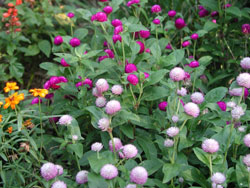Resource Library
Plant of the Week: Globe Amaranth
The University of Arkansas System Division of Agriculture does not promote, support or recommend plants featured in "Plant of the Week." Please consult your local Extension office for plants suitable for your region.
Plant of the Week
Globe Amaranth
Latin: Gomphrena globosa

You only have one chance of making a good first impression. The same principle works with flowers, too. Though I’ve known and grown globe amaranth (Gomphrena globosa) for years, it failed to impress me on our first meeting so I’ve unconsciously given it a ho-hum rating in my mind. But lately this plant seems to have morphed into something much more interesting. It turns out the new look comes from a related species, Gomphrena haageana.
The common Gomphrena seen in gardens is an annual herb in the Amaranth family. It is native to the Old World tropics (probably India) and has long been cultivated as a garden plant. Older selections typically grow about 18 inches tall with a bushy habit and elliptical leaves about two and one-half inches long. Flower colors range from purple to magenta, pink and even white. ‘All Around Purple’ and the Gnome series are commonly available cultivars of this old favorite.
Newer forms of Gomphrena are selections of G. haageana or hybrids between the two species. This species is native to northern Mexico and occurs in the United States in the Rio Grande river valley regions of Texas and New Mexico. It has a more upright, open form with longer, narrower, somewhat pubescent leaves. Flowers are reddish in tone with ‘Strawberry Fields’ and ‘Lavender Lady’ popular offerings.
The flowers of both species of Gomphrena look like a hop clover bloom except in this species the blooms are "everlasting." They are produced at the ends of the stems in a round ball about an inch across. The true flowers are tiny yellow trumpets produced within a tight whorl of papery, persistent bracts that give the flower its everlasting qualities.
Globe amaranth has long been grown in American gardens, being first introduced in 1714. By the early 20th century, the garden books were calling it "an old fashioned annual," a status it retained until the end of the century. But, starting about 1990, the locally grown cut flower market began to emerge as farmers’ markets became more common across the nation. Globe amaranth was used in this market as a cut flower, but the stems were just too short for a lot of growers. G. haageana helped solve this problem by producing plants with longer stems and taller, more open forms. This species is especially late-growing with plants persisting in bloom until the first hard freeze.
The tall Rio Grande globe amaranth is named after Fredric Adolf Haage (1796-1866), a German nurseryman and cacti specialist who established one of the first mail-order seed firms in the world in his hometown of Erfurt, Germany in 1822. His collectors provided seeds of cacti from the deserts of Mexico and the American southwest, and seem to have been responsible for introducing G. haageana into cultivation around 1853. His firm still survives today even though it was nationalized by the East German state in 1970.
Globe amaranth is an easy-to-grow annual that can be started from seed or nursery grown plants. It is a hot-weather plant, so allow the soil to warm before planting seeds or move transplants to the garden after the danger of frost is past. If seeding, soak the seed in water overnight before planting and plant a few extra seeds in each hill because germination is not usually high. It requires full sun and, once established, has moderate drought tolerance. Flowers cut for drying should be harvested when the blooms fully open, bunched and then hung upside down in a dark, well-ventilated room until dry.
By: Gerald Klingaman, retired
Extension Horticulturist - Ornamentals
Extension News - December 4, 2009
The University of Arkansas System Division of Agriculture does not maintain lists of retail outlets where these plants can be purchased. Please check your local nursery or other retail outlets to ask about the availability of these plants for your growing area.